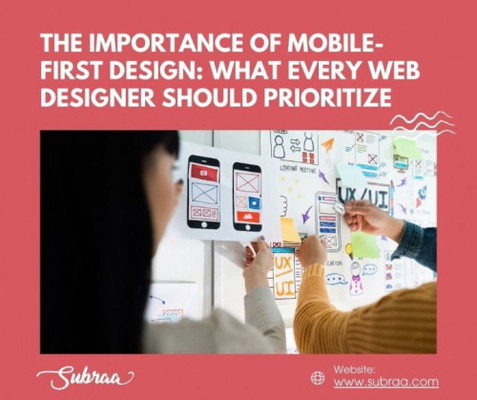The Importance of Mobile-First Design: What Every Web Designer Should Prioritize — Subraa
Mobile-first design has become a critical aspect of creating successful websites. As mobile internet usage continues to surpass desktop browsing, the shift towards prioritizing mobile devices is no longer optional; it’s essential. Every web design company Singapore must now adopt a mobile-first approach to ensure that websites are both user-friendly and fully functional across all devices. Why Mobile-First Design Matters Mobile-first design refers to the process of designing a website with mobile devices as the primary focus, then scaling up for larger screens like tablets and desktops. The importance of this approach lies in the fact that more than half of all web traffic comes from mobile devices. If a website is not optimized for mobile use, businesses risk losing visitors due to slow load times, difficult navigation, or poor readability. For a web design company, incorporating mobile-first design means ensuring that their clients’ websites are adaptable to the smaller screens of smartphones and tablets, which often involves simplifying layouts, optimizing images, and streamlining navigation. This focus not only improves the user experience but also impacts search engine rankings, as Google now prioritizes mobile-friendly websites in its search results. Key Elements Web Designers Should Prioritize Responsive Design A responsive design ensures that a website automatically adjusts to fit any screen size, from a small smartphone to a large desktop monitor. This is one of the core principles every web designer should prioritize when working on mobile-first designs. Without responsive design, users may encounter misaligned content, poor navigation, or frustrating scrolling, all of which can lead to a higher bounce rate. Fast Load Times Mobile users expect quick results, and a slow-loading website can quickly turn them away. Web designers should focus on optimizing load times by compressing images, minimizing code, and leveraging caching techniques. A web design company in Singapore that prioritizes speed will not only enhance user experience but also improve search engine rankings, as page speed is a key factor in Google’s mobile-first indexing. Simplified Navigation Navigation is another critical aspect of mobile-first design. On a smaller screen, it’s important to minimize clutter and create intuitive, easy-to-use navigation menus. Web designers should use collapsible menus (like hamburger menus) and strategically placed buttons to allow users to find the information they need without excessive scrolling or clicking. Touch-Friendly Design Mobile-first design requires a focus on touch interactions. Buttons, links, and form fields should be large enough for users to tap easily without accidentally clicking on the wrong element. A web design company should test their designs extensively on mobile devices to ensure that users can interact with the site without frustration. In a mobile-driven world, prioritizing mobile-first design is no longer just a trend — it’s a necessity. A website design company Singapore that embraces this approach will deliver websites that not only meet the expectations of modern users but also perform well on search engines. For every web designer, focusing on mobile-first design ensures that the websites they create are future-proof, offering an optimal user experience across all devices. By prioritizing responsive design, fast load times, simplified navigation, and touch-friendly interfaces, web designers can make sure their websites stand out in an increasingly competitive digital environment. Pop over here : https://www.subraa.com/


